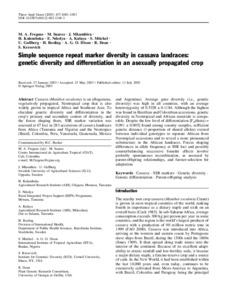| dc.contributor.author | Fregene, M.A. |
| dc.contributor.author | Suarez, M. |
| dc.contributor.author | Mkumbira, J. |
| dc.contributor.author | Kulembeka, H.P. |
| dc.contributor.author | Ndedya, E. |
| dc.contributor.author | Kulaya, A. |
| dc.contributor.author | Mitchel, S. |
| dc.contributor.author | Gullberg, U. |
| dc.contributor.author | Rosling, H. |
| dc.contributor.author | Dixon, Alfred G.O. |
| dc.contributor.author | Dean, R. |
| dc.date.accessioned | 2019-12-04T11:23:52Z |
| dc.date.available | 2019-12-04T11:23:52Z |
| dc.date.issued | 2003 |
| dc.identifier.citation | Fregene, M.A., Suarez, M., Mkumbira, J., Kulembeka, H., Ndedya, E., Kulaya, A., ... & Dean, R. (2003). Simple sequence repeat marker diversity in cassava landraces: genetic diversity and differentiation in an asexually propagated crop. Theoretical and Applied Genetics, 107(6), 1083-1093. |
| dc.identifier.uri | https://hdl.handle.net/20.500.12478/4193 |
| dc.description.abstract | Cassava (Manihot esculenta) is an allogamous, vegetatively propagated, Neotropical crop that is also widely grown in tropical Africa and Southeast Asia. To elucidate genetic diversity and differentiation in the crop's primary and secondary centers of diversity, and the forces shaping them, SSR marker variation was assessed at 67 loci in 283 accessions of cassava landraces from Africa (Tanzania and Nigeria) and the Neotropics (Brazil, Colombia, Peru, Venezuela, Guatemala, Mexico and Argentina). Average gene diversity (i.e., genetic diversity) was high in all countries, with an average heterozygosity of 0.5358 ± 0.1184. Although the highest was found in Brazilian and Colombian accessions, genetic diversity in Neotropical and African materials is comparable. Despite the low level of differentiation [Fst(theta) = 0.091 ± 0.005] found among country samples, sufficient genetic distance (1-proportion of shared alleles) existed between individual genotypes to separate African from Neotropical accessions and to reveal a more pronounced substructure in the African landraces. Forces shaping differences in allele frequency at SSR loci and possibly counterbalancing successive founder effects involve probably spontaneous recombination, as assessed by parent-offspring relationships, and farmer-selection for adaptation. |
| dc.language.iso | en |
| dc.subject | Cassava |
| dc.subject | Genetic Variation |
| dc.subject | Genetic Differentiation |
| dc.title | Simple sequence repeat marker diversity in cassava landraces: genetic diversity and differentiation in an asexually propagated crop |
| dc.type | Journal Article |
| dc.type | Journal Article |
| dc.description.version | Peer Review |
| cg.contributor.crp | Roots, Tubers and Bananas |
| cg.contributor.affiliation | International Center for Tropical Agriculture |
| cg.contributor.affiliation | Swedish University of Agricultural Sciences |
| cg.contributor.affiliation | Agricultural Research Institute, Tanzania |
| cg.contributor.affiliation | Rural Integrated Project Support Programme, Tanzania |
| cg.contributor.affiliation | Karolinska Institute |
| cg.contributor.affiliation | International Institute of Tropical Agriculture |
| cg.contributor.affiliation | Cornell University |
| cg.contributor.affiliation | University of Georgia |
| cg.coverage.region | Africa |
| cg.coverage.region | East Africa |
| cg.coverage.region | West Africa |
| cg.coverage.country | Tanzania |
| cg.coverage.country | Nigeria |
| cg.isijournal | ISI Journal |
| cg.authorship.types | CGIAR and advanced research institute |
| cg.iitasubject | Cassava |
| cg.accessibilitystatus | Limited Access |
| local.dspaceid | 99759 |
| cg.identifier.doi | https://doi.org/10.1007/s00122-003-1348-3 |

